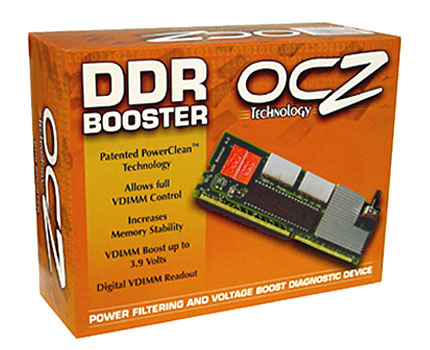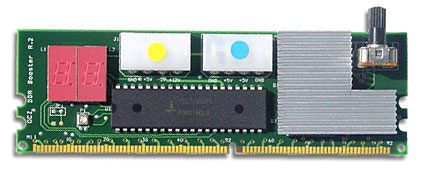OCZ VX Memory + DFI nForce4 = DDR533 at 2-2-2
by Wesley Fink on March 4, 2005 6:45 AM EST- Posted in
- Memory
OCZ EL PC4000 VX Gold
OCZ has developed quite a reputation in the past year with the introduction of many leading-edge memory products. As you will see in a look at our ongoing memory benchmarks, the results have been that OCZ owns many of the top performance spots in our memory tests. Even with that kind of reputation, OCZ VX must be counted a unique product. The EL label is used by OCZ for Extreme Latency, but VX is a new label used to refer to Voltage eXtreme memory. VX means that the memory is designed for and can handle very high memory voltages for expanded performance.The first OCZ VX memory was rated at a very conservative PC3200 2-3-3-8 at a standard 2.6V. While it met these specifications, the specs hardly described a memory that was widely recognized as capable of DDR500 and higher at 2-2-2 timings using voltages of 3.0V and higher. As yields and binning improved, OCZ decided in late February to introduce an updated VX memory - now rated at DDR500 2-2-2 at 3.3V.
The new DDR500 2-2-2 uses the same chips as the earlier VX, but it is binned for higher speed and verified at the new DDR500 specifications. OCZ tells us that everything about the new VX memory is basically the same as earlier PC3200VX, but with even better chips becoming available for VX, it was time for the higher speed rating. OCZ will also be introducing a VX value memory in the future for those enthusiasts that want 2-2-2 timings, but do not demand DDR500+ timings for 2-2-2. Gold VX modules are optimized for use on Athlon 64 based motherboards. In addition, OCZ EL PC-4000 Gold VX is rated to handle up to 3.5V without invalidating the OCZ lifetime warranty.

The new VX DDR500 uses the familiar OCZ Gold heatspreaders. OCZ describes the heatspreaders as gold-mirrored copper, and DDR500 VX is only available as a 1GB kit with two 512MB double-sided memory modules. We removed the heatspreader and found the memory chips were labeled OCZ. OCZ apparently buys memory chip blanks and relabels them for VX. OCZ is usually very open about chip sources, but in this case, they would only comment that the memory chips were made to their specifications and went through extensive binning at OCZ. Forums are claiming that the blank is a new Winbond memory chip.
The recently tested DFI LANParty nForce4 boards are the only current production boards to fully support the voltages required by VX memory. It is fortunate that the DFI are also excellent performers and the DFI LANParty nF4 SLI-DR was the recent winner of our Gold Editors Choice in the nForce4 SLI roundup. The DFI boards are only recently available, however, and prior to the DFIs, there were two ways to use VX memory. First, some enthusiasts modified their boards to supply higher memory voltage.

Second, you could use VX with an OCZ DDR Booster, which is a device designed to fit into the DIMM slot of most motherboards.

The DDR Booster is a little $40 device that allows the user to select voltages up to 3.9V regardless of what voltages the motherboard supports. This neatly gets around the fact that most motherboards supply only 2.7V to 2.85V to the memory slots. For motherboards other than the DFI, you can even buy a bundle of VX memory with the DDR booster.
OCZ EL PC4000 VX Gold Specifications
| OCZ EL PC4000 VX Gold Memory Specifications | |
| Number of DIMMs & Banks | 2 DS |
| DIMM Size Total Memory |
512 MB |
| Rated Timings | 2-2-2-8 at DDR500 at 3.3V 2-3-3-8 at DDR400 at 2.6V (Typically 2-2-2-8 at DDR400 at 3.0V) |
| SPD (Auto) Timings | 3-3-3-8 |
| Rated Voltage | 3.3V |
With Intel's introduction last summer of the Intel 915/925X chipsets with support for DDR2 memory, the primary market for DDR memory has become the excellent AMD Athlon 64 platform. However, some 915 boards also support DDR, and the continuing Intel Socket 478 also supports DDR memory. It is worth noting that OCZ designed PC4000VX for the AMD platform and it is optimized for the Athlon 64 platform. In addition, the only unmodified motherboard for VX is the DFI nForce4 motherboards. For these reasons, OCZ EL PC4000 VX Gold was only tested on the DFI LANParty nF4 SLI-DR Athlon 64 Socket 939 test bed.










67 Comments
View All Comments
Quanticles - Sunday, March 6, 2005 - link
Wesley, it's disturbing that you refuse to re-test other memories on the same test set-up that you used for this memory, or make some other effort to do a fair test set-up.Anandtech really shouldnt be making any assumptions. I dont want to bash... but... how can anyone take these tests seriously? How do we know that OCZ didnt *ask* that this memory to be tested on the DFI board for boosted results? I dont want to say such things, but you're leaving yourself open to these questions.
Wesley Fink - Sunday, March 6, 2005 - link
#38, #40, #41 -In the review we never stated that the other memory chips were tested on the DFI. We pulled the results from our earlier benchmark, since we have already established that the nF3 and nF4 perform virtually the same, and the AGP and PCIe perform virtually the same. In fact, if you check closely, the DFI was a very average performer at stock speeds, so the DFI is not the reason for higher speeeds.
As much as it goes against the grain of many peoples thinking, 2-2-2 on one memory has never performed the same as 2-2-2 on another chip. There are performance differences that can only be explained by difference in the memory chips.
We would have tested on the MSI Neo2 had it supported the voltages needed by VX, but it can't supply them. We do not have a DDR Booster at present so we could not test on another motherboard, so we tested on the only production motherboard to supply voltages needed by the VX.
The 71.80 drivers ARE a bit faster than the 61.77 used for some earlier tests, but the difference is still small and does not change the performance pattern seen in this review. I have posted those benchmarks earlier in these comments.
bigtoe36 - Sunday, March 6, 2005 - link
#44BH5 is about the same speed as VX is
JoKeRr - Sunday, March 6, 2005 - link
I know most BH5 or BH6 will do 250fsb 2-2-2- timing as well with like 3.3Vs. Wesley, how does the BH5 at 250 2-2-2 compare with VX at 2-2-2 250? is bh5 slower or just as fast?? (since u mention "If we had results from older BH5 chips you would likely have seen BH5 perform between Samsung TCCD and OCZ VX", would that be at ddr400? or ddr500? Thankq for the great review, btw when are we goin to see the review for the 24'' and 20'' widescreen dell lcd??JoKeRr - Sunday, March 6, 2005 - link
Rand - Saturday, March 5, 2005 - link
Wesley, I understand the DIMM's are using the same chip and hence unsurprisingly they perform similarly.What I am finding hard to believe is that all of the DIMM's perform identically on two different motherboards, using different graphics drivers.
In every single test the bandwidth never deviates by even 1MB/s or so much as 0.1 FPS.
I would imagine the odds of two different platforms never devaiting in anything by even the sammest margin is bordering on non-existent.
cryptonomicon - Saturday, March 5, 2005 - link
this smells like winbond, especially the settings where it settled best around tras 5 or 6. that is unique to BH5/6. also the voltage is unique to BH5/6 only.a winbond chip if ive ever seen one.
slashbinslashbash - Saturday, March 5, 2005 - link
#35 - That's not what #34 was asking. It's no surprise that sticks of RAM using the same chips will perform similarly.What IS a surprise is that the PQI 3200 Turbo gave 512.9 FPS in Quake 3 Arena in a DFI nF4 motherboard with nVidia 71.80 drivers, and it also happened to get 512.9 FPS in Quake 3 Arena in an MSI nF3 motherboard with nVidia 61.77 drivers (as shown in your January 4th review of the Corsair PC4400). This exact sameness in benchmark numbers is the same down the line, with every type of RAM and every benchmark -- both gaming and synthetic. I checked every single number.
There's no need to re-test all of the 7 types of RAM in the DFI board with the newer drivers. Just a couple, say the Crucial and the Geil, so we can know that the conclusions are valid.
frodin - Saturday, March 5, 2005 - link
"With nForce3 motherboards, we achieved the fastest performance on AMD Athlon 64 chipsets (nForce3, VIA K8T800 PRO) at Cycle Time or tRAS of 10."Are you saying there are nForce3 motherboards out there with VIA chipsets? ;-) I know it is probably a typo, nevermind.
However, i thought the tras 10- thing was a odd behaviour of the nforce2/3 chipsets only, not the VIA K8T800 PRO too.
Otherwise, good review, as always. These chips would be something to look for here in Norway, considering the fact that vx3200- ram is no more expensive than TCCD- chipped ram.
ozzimark - Saturday, March 5, 2005 - link
#35-wes, you're right there, but it doesn't help explain the profound performance differencce seen in the gaming tests and unbuffered bandwidth... it all adds up to the dfi providing better memory/graphics performance in my mind.